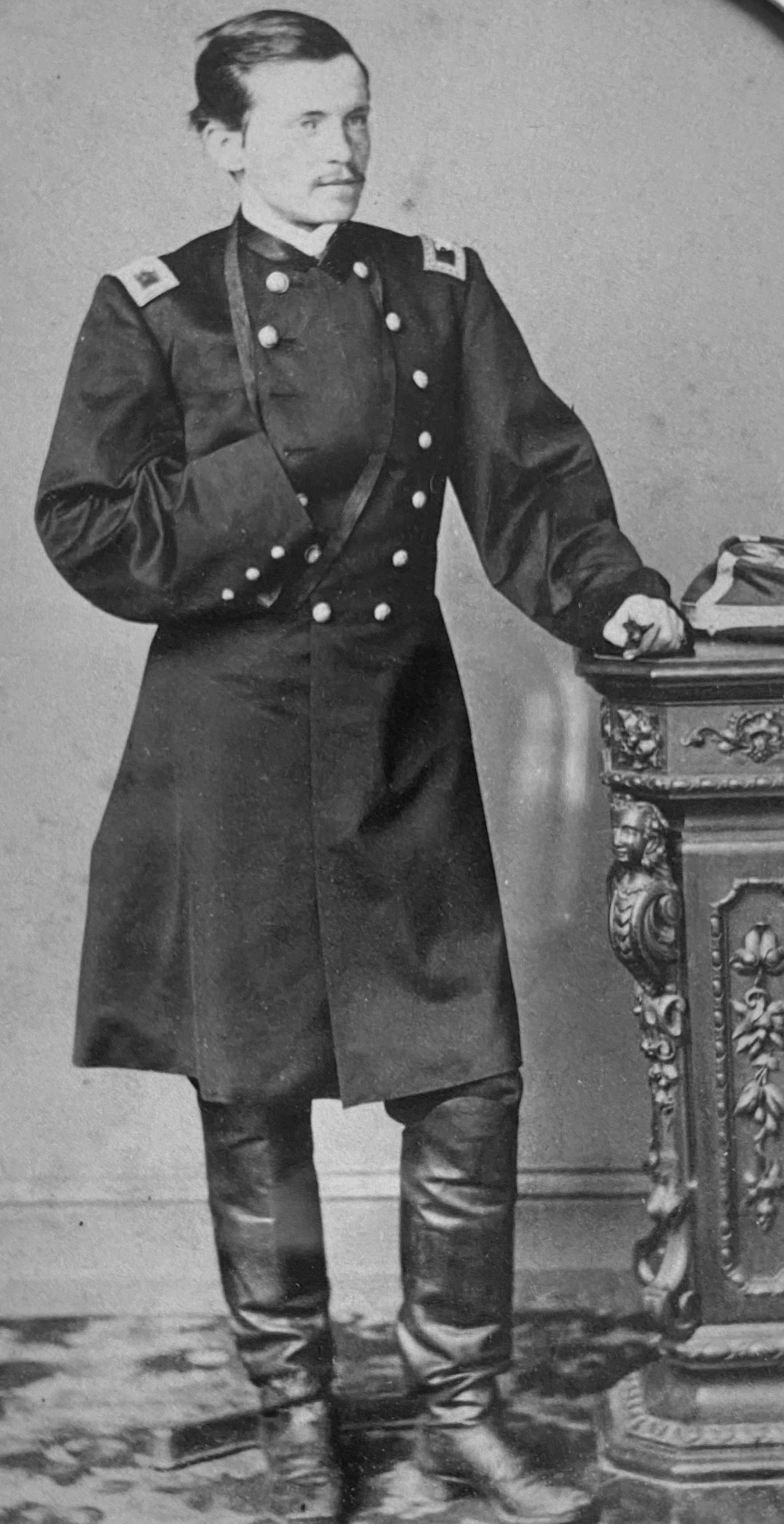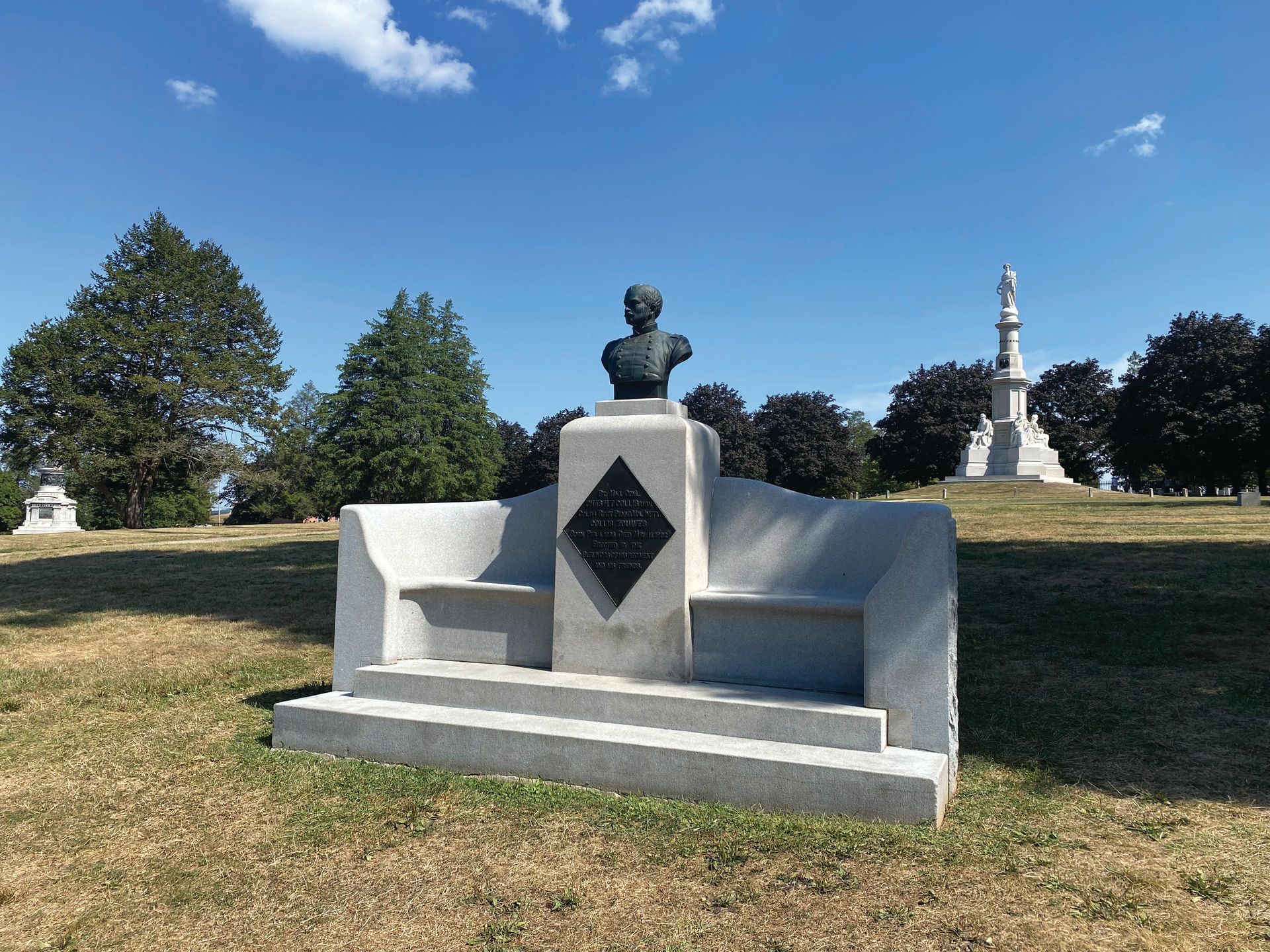General Charles Collis: "So Positive a Character"
by Diana Loski

General Charles Collis
(1838-1902)
(Ronn Palm Museum, Gettysburg)
The Soldiers National Cemetery at Gettysburg was the first of all U.S. National Cemeteries in the world, dedicated on November 19, 1863 while it was yet incomplete. It stands today as the model of remembrance for all who risked – and gave – the supreme sacrifice for the United States.
From the Civil War through both World Wars and beyond, Gettysburg’s National Cemetery houses the remains of thousands. Some who survived war and wished their interment among those who fought with them are also laid to rest there. Among them is the highest ranking general in the National Cemetery, whose grave is found among the Pennsylvania slain from the Battle of Gettysburg. He was one of the more fortunate who lived until the beginning of the twentieth century. At his death, his final wish was to have his grave among those of his cherished 114th Pennsylvania Infantry. He was Brevet Major General Charles H.T. Collis.
Charles Henry Tucker Collis was born on February 4, 1838 in Cork, Ireland, one of nine children born to William Collis, a farmer, and his wife, Mary Lloyd Collis. As the potato famine caused great havoc in that unfortunate country through the 1840s, the Collises – unable to afford passage to the United States with so large a family – migrated instead to Glasgow, Scotland. William and Mary Collis hoped to save enough money to eventually take their entire family to America.1
A few years after settling in their new country, specifically from 1852 through 1854, a devastating cholera epidemic swept through the British Isles. It reached Glasgow in 1854, infecting the majority of the Collis family. Charles’s mother and all of his siblings perished in the pandemic, leaving only Charles, age 15, and his bereaved father. William Collis then booked passage for the United States for him and for his son. They arrived in Philadelphia later that year.2
In 1859 Charles Collis was admitted to the bar in Philadelphia. He practiced for only two years before war erupted. Eager to protect the country he now called home, Collis was one of the first to enlist – joining the 18th Pennsylvania Infantry, a three-month unit. While serving in that capacity, Collis attained the rank of Sergeant-Major. When the three-month tenure ended for his regiment, Collis returned to Philadelphia and raised a unit of Zouaves – the 114th Pennsylvania Infantry, of which he was their colonel. The unit, nicknamed Collis’s Zouaves, began their service to the Union in August 1861.3
A Zouave regiment, of which Collis and his troops were one of several, wore a slightly different uniform than the usual Union blue. Fashioned after the stylish North African soldiers from the recent Crimean War in Europe, the men sported bright red and usually baggy pantalons, a trim blue jacket bordered with red, and a tasseled fez atop their heads in place of a kepi. Instead of brogans, the Zouaves wore ankle-length boots, covered by white cloth or canvas leggings called gaiters, that reached almost to the knee. Their uniforms were decidedly colorful, making them less camouflaged and therefore easier targets. The soldiers proudly wore their uniform, unafraid of being so flagrantly visible in battle.
A few months after his enlistment, Collis wed Septima Levy, whom he had met in Philadelphia. They were married on December 9, 1861. Four children were eventually born to the couple, one of whom died in infancy. Like most wives of enlisted men during the war, Mrs. Collis remained in Philadelphia, soon finding herself with child, and living with her father-in-law while her husband fought for his country.4
Collis and his Zouaves first served in the Shenandoah Valley under the command of General Nathaniel Banks. By the summer of 1862, they were transferred to the Army of the Potomac.
Collis and his 114th Pennsylvania fought with distinction at the Battle of Fredericksburg. Colonel Collis “gallantly led his regiment in battle at a critical moment” upon Marye’s Heights. Collis later received the Congressional Medal of Honor for his action in that battle.5
The 114th Pennsylvania, with their commander, endured the terrible Mud March in January, 1863 and fought at the Battle of Chancellorsville in early May. Collis was wounded in the fight, and afterward contracted the dreaded typhoid fever. The combination of his significant wound and the ensuing illness debilitated him, and he had to return to Philadelphia to recuperate. As a result, he missed the Battle of Gettysburg.6
While Collis was not present at the pivotal battle in Pennsylvania, his regiment nevertheless did participate. With Collis’ second-in-command, Colonel Frederick Cavada, the Zouaves fought with great valor in the Sherfy Peach Orchard on July 2, 1863. As part of Dan Sickles’s Third Corps, the troops were placed in an untenable position near the Emmitsburg Road. The regiment lost heavily in battle. Among the casualties was Colonel Cavada, who was taken prisoner. Many of the wounded were carried to the Sherfy barn, which then caught fire. While many of Collis’s Zouaves were listed as missing in action, some of those perished in the barn and were subsequently unrecognizable.7
Colonel Collis finally healed from his wound and his illness by the middle of August 1863. He continued to lead his regiment though the rest of the year, including participating in Bristoe Station and the Mine Run Campaign. He led his Zouaves at the Battles of the Wilderness and Spotsylvania. His courage under fire caught the notice of General Ulysses S. Grant, who was now in charge of all Union armies and present at the battle. A promotion to brigadier general was made official by President Lincoln on December 12, 1864.8
Collis and his brigade, which included his beloved Zouaves, fought at Petersburg and remained during the siege of that city, which finally fell on April 2, 1865. Collis and his men then occupied Petersburg as part of the Union Fifth Corps, as the Third Corps ceased to exist after Gettysburg. They were present at Lee’s surrender at Appomattox, then sent to Washington, D.C. They were mustered out on May 29, 1865. General Collis ended the war as a Brevet Major-General of Volunteers.9
Collis returned to Philadelphia to his wife and daughter, Amelia. He returned to practicing law, until he was made Commissioner of Public Works in New York City. He moved his family to Manhattan, where they lived for many years. Collis modernized the city that many of us still know today. He solved the problems of water distribution for the growing populace, he put in the street lights for New York City, and even paved the streets and sidewalks – including the pavement down Fifth Avenue. He was, one contemporary remarked, “an active, interesting, lovable man, full of energy, invention, and initiative, kindness and loyalty.”10
Collis’s ingenuity and active work ethic made him a millionaire. Two sons were born after the war to him and his wife: Lloyd in 1871 and Charles Jr. in 1881. The Collises had two substantial estates: one in Manhattan and one in Philadelphia.
Upon his retirement, General Collis decided to build a summer home in Gettysburg – the one place where he had missed a significant Civil War battle. The home, completed in 1900 and located on South Confederate Avenue, is named Red Patch – the insignia of his unforgettable 114th Pennsylvania Infantry. Collis’ men at Gettysburg had been part of the First Brigade, First Division, Third Corps. Each Union corps had a symbol, and the diamond belonged to Sickles’s Third Corps. The divisions were divided into colors: red, white, and blue. Since Collis’s regiment was part of the First Division, the color of their diamond patch was red – hence the name.11
The monument to the 114th Pennsylvania stands at the front of the Sherfy Farm on the Emmitsburg Road, with a Zouave soldier proudly loading his musket. On the memorial are these words: “In the memory of the heroic men of that command, who here laid down their lives in defense of their country’s flag.”12
When Collis and his family were in Gettysburg for the summer, the veteran was always eager to participate in civic and memorializing events. For the short time he summered in Gettysburg, he became greatly admired and made lasting friendships. He often paid his respects at the National Cemetery, especially among the members of his old command.13
During the spring of 1902, General Collis was at Red Patch while his wife embarked on a long summer trip to Europe and Russia. A cancerous growth soon represented itself, and proved dangerous enough for him to return to Philadelphia for an operation.14
Collis was admitted to Bryn Mawr Hospital and submitted to surgery. One journalist noted that “General Collis stood the operation well, although his condition was extremely critical.” His daughter, Amelia and his two sons were by his side through the ordeal, and Mrs. Collis was notified in France. She quickly booked passage home, hoping to reach her husband’s side.15
The general failed to recover from the operation and the cancer, and died the next day, on Sunday, May 11, 1902. His three grown children were at his side in Bryn Mawr. On the following Wednesday, his funeral took place in St. Stephen’s Episcopal Church in Philadelphia, where “prominent men from Philadelphia, New York, and Washington were present.” On Thursday, the general’s remains were placed on a train and taken to Gettysburg, where General Collis was buried in the National Cemetery. The grave stands in the Pennsylvania section, near some of the men from his command who had perished at Gettysburg. Collis was buried there “according to the General’s wish.”16
Today, the grave of General Collis is easily distinguishable among the many that surround it. His death affected many. One who knew him wrote, “General Collis was too positive a character not to have made a deep mark and to leave lasting memories.”17
The evidence of his devotion is manifested in his final resting place, on a sacred hill at Gettysburg.

The Collis grave, Soldiers National Cemetery
(Author photo)
Sources: The 114th Pennsylvania File, Gettysburg National Military Park (hereafter GNMP). The 114th Pennsylvania Infantry Memorial, Gettysburg. Ancestry.com: Charles Collis Family Tree. Chamberlain, John. John Chamberlain Diary, Pejepscot Historical Society, Brewer, Maine. Gettysburg/stonesentinels.com. Medal of Honor: moh.org/recipient/charles-h-collis. The New York Sun, 20 May 1902. The New York Tribune, 14 May, 1902. U.S. Census, New York City, 1900.
End Notes:
1. New York Tribune, 14 May, 1902.
2. New York Tribune, 14 May, 1902. U.S. Census, 1900. In the census, Collis attests to the date of his departure to the U.S.
3. 114th PA File, GNMP.
4. Collis Family Tree, Ancestry.com.
5. Moh.org/recipients/charles-h-collis.
6. Ibid.
7. 114th PA Memorial, Gettysburg. John Chamberlain Diary, PHS. The civilian brother of Joshua Chamberlain recorded the sights of the many dead in the Peach Orchard, including the 114th PA.
8. New York Tribune, 14 May, 1902.
9. New York Sun, 20 May, 1902. The Union First Corps also ceased to exist after Gettysburg, due to the number of casualties, much like the Third Corps.
10. Ibid.
11. Gettysburg/stonesentinels.com.
12. 114th PA Memorial, Gettysburg.
13. New York Sun, 20 May, 1902.
14. Ibid.
15. New York Tribune, 14 May, 1902. Mrs. Collis was unable to reach home before her husband’s death and burial.
16. The New York Sun, 20 May, 1902.
17. Ibid.
Author’s Note: General Collis’ s Gettysburg home, Red Patch, still stands on South Confederate Avenue. It remains a private residence.

